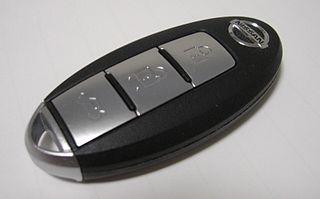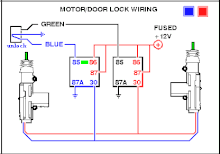
Motor vehicle theft or car theft is the criminal act of stealing or attempting to steal a motor vehicle.

A car alarm is an electronic device installed in a vehicle in an attempt to discourage theft of the vehicle itself, its contents, or both. Car alarms work by emitting high-volume sound when the conditions necessary for triggering it are met. Such alarms may also cause the vehicle's headlights to flash, may notify the car's owner of the incident via a paging system, and may interrupt one or more electrical circuits necessary for the car to start. Although inexpensive to acquire and install, the effectiveness of such devices in deterring vehicle burglary or theft when their only effect is to emit sound appears to be negligible.

The Renault Fuego is a sport hatchback that was manufactured and marketed by Renault from 1980 to 1986, replacing the Renault 15 and 17 coupés of the 1970s.

A smart key is an electronic access and authorization system that is available either as standard equipment or an option in several car designs. It was developed by Siemens in 1995 and introduced by Mercedes-Benz under the name "Keyless-Go" in 1998 on the W220 S-Class, after the design patent was filed by Daimler-Benz on May 17, 1997.

A power seat in an automobile is a seat in a passenger compartment that can be adjusted using a button, switch or joystick and a set of small electric motors. Most cars with this feature have controls for the driver's seat only, though almost all luxury cars also have power controls for the front passenger seat.

A car key or an automobile key is a key used to open and/or start an automobile. Modern key designs are usually symmetrical, and some use grooves on both sides, rather than a cut edge, to actuate the lock. It has multiple uses for the automobile with which it was sold. A car key can open the doors, as well as start the ignition, open the glove compartment and also open the trunk (boot) of the car. Some cars come with an additional key known as a valet key that starts the ignition and opens the driver's side door, but prevents the valet from gaining access to valuables that are located in the trunk or the glove box. Some valet keys, particularly those to high-performance vehicles, go so far as to restrict the engine's power output to prevent joyriding. Recently, features such as coded immobilizers have been implemented in newer vehicles. More sophisticated systems make ignition dependent on electronic devices, rather than the mechanical keyswitch. A number of these systems, such as KeeLoq and Megamos Crypto have been demonstrated to be weak and vulnerable to cryptanalytic attacks.

A remote keyless system (RKS), also known as remote keyless entry (RKE) or remote central locking, is an electronic lock that controls access to a building or vehicle by using an electronic remote control (activated by a handheld device or automatically by proximity). RKS largely and quickly superseded keyless entry, a budding technology that restrictively bound locking and locking functions to vehicle-mounted keypads.

A keypad is a block or pad of buttons set with an arrangement of digits, symbols, or alphabetical letters. Pads mostly containing numbers and used with computers are numeric keypads. Keypads are found on devices which require mainly numeric input such as calculators, television remotes, push-button telephones, vending machines, ATMs, point of sale terminals, combination locks, safes, and digital door locks. Many devices follow the E.161 standard for their arrangement.

The Jeep Cherokee (XJ) is a sport utility vehicle manufactured and marketed across a single generation by Jeep in the United States from 1983 through 2001 — and globally through 2014. It was available in two- or four-door, five-passenger, front-engine, rear- or four-wheel drive configurations.
A rolling code is used in keyless entry systems to prevent a simple form of replay attack, where an eavesdropper records the transmission and replays it at a later time to cause the receiver to 'unlock'. Such systems are typical in garage door openers and keyless car entry systems.

An ignition switch, starter switch or start switch is a switch in the control system of a motor vehicle that activates the main electrical systems for the vehicle, including "accessories". In vehicles powered by internal combustion engines, the switch provides power to the starter solenoid and the ignition system components, and is frequently combined with the starter switch which activates the starter motor.
A keycard lock is a lock operated by a keycard, a flat, rectangular plastic card. The card typically, but not always, has identical dimensions to that of a credit card, that is ID-1 format. The card stores a physical or digital pattern that the door mechanism accepts before disengaging the lock.
KeeLoq is a proprietary hardware-dedicated block cipher that uses a non-linear feedback shift register (NLFSR). The uni-directional command transfer protocol was designed by Frederick Bruwer of Nanoteq (Pty) Ltd., the cryptographic algorithm was created by Gideon Kuhn at the University of Pretoria, and the silicon implementation was by Willem Smit at Nanoteq (Pty) Ltd in the mid-1980s. KeeLoq was sold to Microchip Technology Inc in 1995 for $10 million. It is used in 'hopping code' encoders and decoders such as NTQ105/106/115/125D/129D, HCS101/2XX/3XX/4XX/5XX and MCS31X2. KeeLoq has been used in many remote keyless entry systems by such companies like Chrysler, Daewoo, Fiat, Ford, GM, Honda, Mercedes-Benz, Toyota, Volvo, Volkswagen Group, Clifford, Shurlok, and Jaguar.

A car door is a type of door opening, typically hinged on its front edge, but sometimes attached by other mechanisms such as tracks, for entering and exiting a vehicle. Doors most often integrate side windows for visibility from inside the car and can be locked to secure the vehicle.

The first generation Subaru Legacy is a mid-size family car / wagon developed by Fuji Heavy Industries. The Legacy was an all new model, and was considered a notable departure from Subaru products in the past.

The second-generation Subaru Legacy was marketed in Japan from October 1993, and July 1994 marked the second generation in North America with a full body and chassis revision. The exterior was designed by Olivier Boulay in 1991, during his tenure at Subaru. The tail light appearance on both the sedan and wagon was influenced by the taillights on the SVX.

A smart lock is an electromechanical lock that is designed to perform locking and unlocking operations on a door when it receives a prompt via an electronic keypad, biometric sensor, access card, Bluetooth, or Wi-FI from a registered mobile device. These locks are called smart locks because they use advanced technology and Internet communication to enable easier access for users and enhanced security from intruders. The main components of the smart lock include the physical lock, the key, a secure Bluetooth or Wi-Fi connection, and a management mobile app. Smart locks may also monitor access and send alerts in response to the different events it monitors, as well as other critical events related to the status of the device. Smart locks can be considered part of a smart home.

The Jeep Grand Cherokee (ZJ) is the first generation of the Jeep Grand Cherokee sport utility vehicle. Introduced in 1992 for the 1993 model year, development of the ZJ Grand Cherokee started under American Motors Corporation (AMC) as a mid-sized successor to the compact Jeep Cherokee (XJ) intended to replace both it and the aging Jeep Wagoneer (SJ) and was continued after the company was acquired by Chrysler in 1987.

UniKey Technologies is an alternative access control company based in the United States that designs and licenses keyless entry technology worldwide. Its first product in partnership with Kwikset was Kēvo, a Bluetooth-enabled deadbolt door lock.
Automotive hacking is the exploitation of vulnerabilities within the software, hardware, and communication systems of automobiles.

















